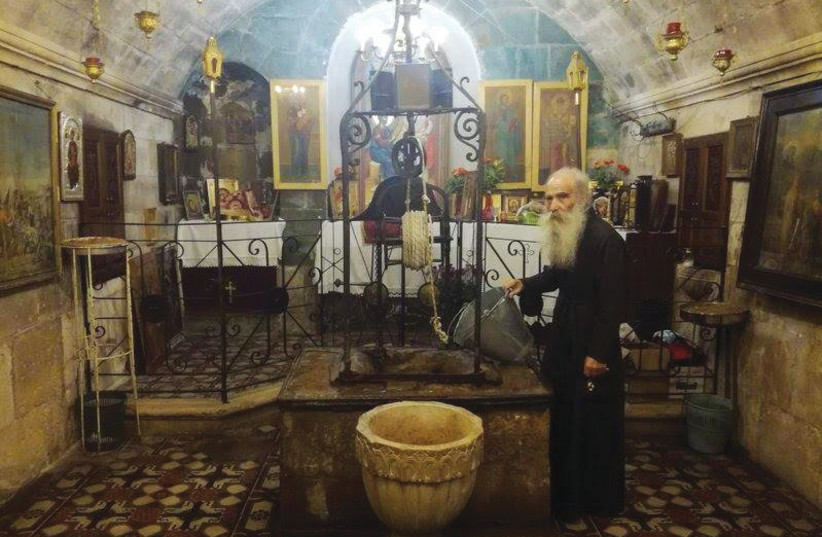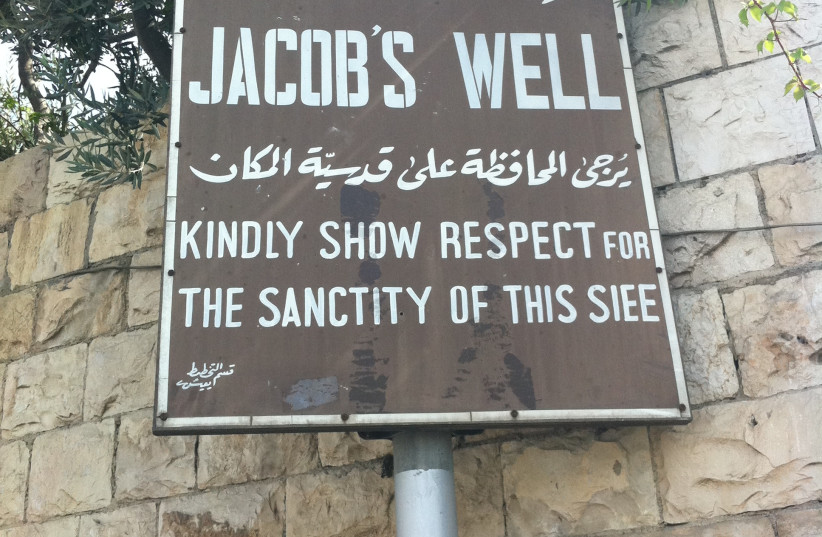NABLUS – For the last 41 years, 81-year-old Archimandrite Ioustinos has faithfully served as custodian of the Greek Orthodox church of Jacob’s Well here, an impressive holy site in this Palestinian city of 130,000 across the street from the Balata Refugee Camp.
The complex – revered in the Jewish, Samaritan, Christian and Muslim traditions – looks like it belongs in the Peloponnese or Mount Athos.
Ioustinos, also spelled Eustinus, is more than the guardian. He served as the unofficial engineer/architect who built the basilica that replaced the church and small monastery dating from 1893, which was damaged in the 1927 earthquake. He also raised the funds for the decades-long project that was completed in 2018, and painted the church’s icons and frescoes. Perhaps most important, he has been the barkeeper, offering pilgrims of different faiths a refreshing draft of liquid love, peace and coexistence drawn from the 41-meter well found in the church’s crypt.

That deep spring, which lends its name to the church, is not specifically mentioned in the Torah. But Genesis 33:18-20 states that when Jacob the Patriarch returned to Shechem from Paddan-aram in modern Turkey, he camped “before” the city, bought the land on which he pitched his tent, and erected an altar. Genesis is mute about whether Jacob dug a well to guarantee water for his extensive flocks of sheep and goats. Some exegetes link the well in the “open country” of the “land of the Kedemites” in Genesis 29 to where Jacob meets his bride, Rachel.
The site – also known as Jacob’s Fountain and the Well of Sychar – is certainly ancient. In the New Testament (John 3:5-6), Jesus encountered a Samaritan woman here, to whom he said “Let me drink.” According to tradition, the amphora carried by that the woman – known as St. Photini (the enlightened one) in Greek Orthodox lore – is preserved as a relic in the church, as is a fragment of her skull.

Equally impressive are the ornate Eastern Orthodox-style paintings, sculptures, stained glass and mosaics that decorate the church, all the legacy of Ioustinos.
Dressed in his priestly black robe and cap, and today walking with a cane, he painted everything.
His favorite, he says, is the one decorating the church’s dome depicting Jesus surrounded by his 12 disciples. He dedicated six months to painting the ceiling.
Born in the Greek island of Ikaria during the Italian occupation of the Dodecanese, Ioustinos studied gold and silversmithing, But his heart was elsewhere. Arriving in 1960 when Jordan controlled the West Bank, he originally settled in east Jerusalem followed by stints in Beit Jala – then an Arab-Christian town adjoining Bethlehem – and Tiberias.
Ioustinos was appointed to his present position under tragic circumstances. In November 1979, his predecessor, Archimandrite Philoumenos, was murdered inside the crypt housing the well by Asher Raby, a mentally ill resident of Tel Aviv. In 2009, 30 years after his martyrdom, Jerusalem’s Greek Orthodox Patriarch Theophilos III beatified Philoumenos.
While the murder was frightening, even tenser times lay ahead for Ioustinos. During the Second Intifada in the early 2000s, Nablus was the scene of frequent battles between IDF soldiers and Palestinian rioters. Many suicide bombers came from Nablus, and the IDF – which pulled out of the city in 1995 and handed over control to the Palestinian Authority – returned and imposed curfews and closures. Locked in his church, Ioustinos turned to painting to pass the time. He also dreamed of rebuilding the earthquake-damaged church, which was first erected in the Byzantine period 14 centuries earlier.
With the Second Intifada finally over and the Palestinians in control of the city under the Oslo Accords, Yasir Arafat – then the president of the Palestinian Authority – granted Ioustinos his long-sought building permit. Arafat offered to pay for the construction, but Ioustinos refused the funding so as to preserve his church’s independence.
“I didn’t take the money from him so there wouldn’t be problems in the future,” he says. “Why? Because this place belongs to three religions: Jews, Christians and Muslims.”
What of the various icons, mainly depicting mainly of Jesus, Mary, saints and angels in a style that Eastern Orthodox artists have followed for centuries?
“I can’t just do what I like,” Ioustinos explains, saying he is bound by the traditions of ecclesiastical art. “Michaelangelo made art, not icons. This is the life of the Greek Orthodox.”
On an exterior wall of the church, Ioustinos has made a mosaic depicting himself, placed next to a simply decorated grave that he prepared for himself 14 years ago.
But Ioustinos has a towering ambition to complete before he can retire to his well-deserved eternal rest.
“I really hope to get permission to build a church in Sebastia [north of Nablus], on the site where John the Baptist was beheaded. The area has been in the possession of Muslims for 240 years, and I bought it about 36 years ago. I ask the Lord, before closing my eyes, to give me permission to complete this church, the Church of John the Baptist.”
In the meantime, Ioustinos encourages tourists and pilgrims to come to Nablus.
“For 60 years I’ve been in a holy land,” he says. “All of the tourists who come to Israel and Palestine should come here. It’s a religious, archaeological and historical place. Everything is found here.” ■
The writer is a licensed tour guide who leads tours to the Nablus area. The city itself is in Area A. Entry is forbidden to Israeli citizens.
